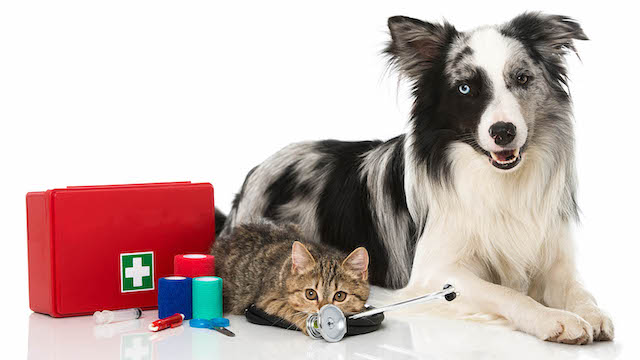Contributed by Jennifer Dew, 9 to 5 Pets
Would you know what to do if:
- Your dog ate a chocolate bar left out on your kitchen counter or a dishwasher pod that fell out onto your floor?
- Your cat had a seizure right in front of you?
- Your dog overheated on a hot summer day?
- Your cat got hit by a car?
 We never want to believe we’ll be faced with these kinds of emergencies. But accidents do happen and the last thing we want to do is panic. In any medical emergency, the best course of action is to bring your pet to a veterinarian as soon as possible. However, being prepared to respond to an accident with first aid care may help save your pet’s life until it receives veterinary treatment.
We never want to believe we’ll be faced with these kinds of emergencies. But accidents do happen and the last thing we want to do is panic. In any medical emergency, the best course of action is to bring your pet to a veterinarian as soon as possible. However, being prepared to respond to an accident with first aid care may help save your pet’s life until it receives veterinary treatment.
Did you know each Pet Care Professional on our 9 to 5 Pets team is certified in Pet First Aid & CPR? Being prepared to care for your pet in the event of an emergency is a priority for us. Since April is Pet First Aid Awareness month, we’ve compiled some tips to help prepare and empower you to be the best first responder you can be for your pet:
Gather Your First Aid Supplies
The first step in being prepared is having the right supplies within reach. Use this checklist when you are out shopping next to build your own first aid kit for your pet:
- Pet medical records including medication and vaccination history
- Contact information for your local veterinarian
- Contact information for your local emergency vet clinic
- Animal Poison Control Center Hotline (available 24/7/365): (888) 426-4435
- Gauze for wrapping wounds or muzzling the injured pet
- Non Stick bandages, towels, or strips of clean cloth to control bleeding or protect wounds
- Adhesive tape for securing the gauze wrap or bandage
- Milk of magnesia activated charcoal to absorb poison and hydrogen peroxide (3%) to induce vomiting (always contact your veterinarian or poison control center before inducing vomiting or treating an animal for poison)
- Digital “fever” thermometer to check your pet’s temperature (their temperature must be taken rectally, not orally)
- Eye dropper to give oral treatments or flush wounds
- Muzzle, rope, necktie, soft cloth, nylon stocking, or small towel to cover your pet’s head
Leash to transport your pet - Stretcher, board, blanket or floor mat to stabilize the animal and prevent further injury during transport
What To Do In Common Emergency Situations
 CHOKING
CHOKING
If your pet is choking but can still breathe, bring them to the vet as soon as possible. If their tongue or gums are turning blue and they’re in obvious distress, put your hand over the top of their muzzle and lift it up to open their mouth. Don’t cover their nostrils. Use needle-nose pliers to remove an object that’s clearly visible, but be careful not to force the object farther down into their throat. Use caution, because an animal in this situation may panic and bite. If that doesn’t work, lay your pet on their side, and then place your hands at the very end of their rib cage. Push down and slightly forward, applying pressure in quick, firm strokes. If you can’t dislodge the object, get to the vet immediately.
CPR may be necessary if your pet remains unconscious after you have removed the choking object. First check to see if they are breathing. If not, place them on their side and perform artificial respiration by extending their head and neck, holding their jaws closed, and blowing into their nostrils once every three seconds. (Ensure no air escapes between your mouth and your pet’s nose.) If you don’t feel a heartbeat, incorporate cardiac massage while administering artificial respiration—three quick, firm chest compressions for every respiration—until your dog resumes breathing on his own.
 POISONING
POISONING
If you believe your pet has eaten something toxic, call your vet or the ASPCA Pet Poison Hotline (888-426-4435) right away. Unless instructed to do so by a veterinarian, never induce vomiting. Many toxins are corrosive, and vomiting may damage the esophagus or cause choking. Should your vet tell you to induce vomiting, they will provide you with a recommended dose of 3% hydrogen peroxide, based on your dog’s weight (usually 1 teaspoon per 5-10 lbs). There are no safe and reliable at-home products that can be used to induce vomiting in cats, so always get your feline to a veterinary clinic for treatment. In either case, take your pet to the vet as soon as possible.
 CUTS, PUNCTURES, OR BITES
CUTS, PUNCTURES, OR BITES
All punctures, bites, and cuts have the potential to become infected, so they need to be checked out by a vet. If your pet is bleeding profusely, cover the area with sterile gauze and a clean towel, and then apply direct pressure until a clot forms. If there’s an object penetrating the wound, like a stick, do not attempt to remove it. If the wound is not bleeding, remove any debris you see and clean the area with sterile saline solution or clean water. (Note: Do not use alcohol or hydrogen peroxide, which can damage the tissue.) Apply clean gauze and wrap a bandage around it to keep the area clean and stop your cat or dog from licking it.
 CAR TRAUMA
CAR TRAUMA
If your pet gets hit by a car, lay them on a flat board and strap them down to help prevent movement. Make sure you don’t put pressure on their chest, which can hinder breathing. If you suspect your pet has sustained a head injury, tilt the board so that your pet’s head is slightly above its body during transport. If you see any broken bones, do what you can to minimize excessive motion, but don’t attempt to splint them. Once inside the car, cover your cat or dog with a blanket to help prevent shock.
After any car trauma — even if your pet does not appear to be injured — it’s still critical you have a vet examine them. Many animals suffer internal injuries that are not obvious, and they may be very serious if not given immediate veterinary attention.
SEIZURES
If your cat or dog has a seizure, move furniture and other objects out of the way to help prevent further injury. Do not attempt to restrain your pet and keep your hands away from their mouth — pets will not swallow their tongues, but chances are they will involuntarily bite you. Most seizures won’t last more than five minutes. Regardless of how long the seizure lasts, your pet needs to see a veterinarian immediately.
 OVERHEATING
OVERHEATING
Unlike us, dogs don’t sweat out excess body heat. Though dogs typically release heat by panting, this may not always be enough to cool them down. As a result, your dog can quickly become overheated, if not acclimated. Symptoms include:
- Excessive panting and shortness of breath
- Excessive drooling
- Gum discoloration
- Fever (a body temperature above 103 degrees is considered abnormal)
- Increased pulse and heartbeat
- Excessive thirst
- Disorientation, stumbling or weakness
- Vomiting
If your dog is overheating, get them indoors to a cool place, like an air-conditioned room or in front of a fan. Place cool, wet cloths or towels on their neck, armpits, or behind their hind legs. You can also gently wet their ears and paws with cool water. (Note: Do not use cold water. Cooling them too quickly can be just as dangerous as heat exhaustion.) If they are willing to drink, offer them cool or lukewarm water, but do not force them. Call your veterinarian as soon as possible. Even if your dog seems to be recovering, they may need to be monitored for shock, dehydration, kidney failure, and other possible complications of heat exhaustion. Your vet will be able to advise you about next steps. If your dog loses consciousness or begins vomiting, seizing, etc. take them to a vet or emergency animal hospital right away.
If you are interested in becoming certified in Pet CPR and First Aid, check out ProTrainings “Pro Pet Hero” online course.
Have fun with your pets, stay safe, and always be prepared!
References:
Vetstreet.com
American Veterinary Medical Association
ASPCA

